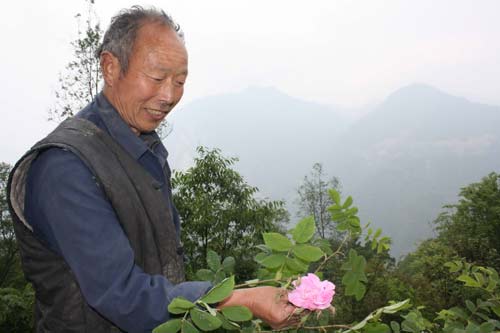Society
Quake lake coming up roses
By Guo Shuhan (China Daily)
Updated: 2010-07-24 06:49
 |
Large Medium Small |
|
 The blooming business brings new hope to local farmers in Beichuan, Sichuan province. [Tang Xiaojun / For China Daily] |
The people living around Tangjiashan Lake, in Beichuan county, Sichuan province, which was formed by landslides triggered by the devastating May 12 earthquake two years ago, are hoping the lake will capture the world's attention once again.
The once threatening lake has taken on a new tranquility surrounded by flamboyant, fragrant roses.
Last March, the first batch of 60,000 Damask rose seedlings were delivered from a flower seedling center in Shanxi province. The seedlings were distributed to villagers in Xuanping township living beside the lake, who were willing to try the roses as a new cash crop.
According to Luo Shide, an expert with the Beichuan agriculture bureau, the soil condition, climate and ecological environment of Beichuan, are similar to those of the "Valley of Roses" in Kazanlak, Bulgaria, and make it the perfect place to grow roses.
"In terms of sunshine and rainfall, the areas surrounding the quake lake are ideal for rose cultivation," says another rose expert, Wang Xichun.
Ten of the 19 villages of Xuanping started cultivating 200 mu (13 hectares) of roses last year, as an alternative to traditional crops, such as corn and tea. The planting area varies for each household and ranges from one or two mu to more than 10 mu.
Another two townships around the quake lake, Yuli and Baini, have also begun rose cultivation since early this year.
It is hoped that within a few years, China's largest rose production base will be established, with a total area for the three townships of 5,000 mu (330 hectares).
If everything goes smoothly, the long-term plan is a 20,000-mu cultivation area, turning the whole place around the lake into an exuberant rose valley.
The first harvest season for flower growers at Xuanping came this May. The highest yield was 40 kg per mu.
Liu Bin, resident of Jingjia village at Xuanping, used 70 percent of his field for roses. "On average, each of my seedlings generated around 200 buds this year, more than I expected," Liu says.
"This type of rose will not produce its full harvest until the third year. Production per mu can reach to 300 or 400 kg," says Zhao Ping, vice manager of Beichuan Futai Rose Ltd, which is in charge of the whole rose valley project, with the local government.
Flower growers sign a 15-year contract with the company, during which period the company guarantees to provide continual technical help and to purchase all blooms at a price of 6 yuan ($0.89) per kg.
Rosa damascena, more commonly known as the Damask, is a rose hybrid derived from Rosa gallica and Rosa moschata.
"This type of rose is renowned for its rich essential oil content. The oil has an average market price of no less than 30,000 yuan ($4,425) per kg," Wang Xichun says.
Later this year, Beichuan Futai Rose Ltd will establish the first local rose oil plant.
"The plant will provide around 20 permanent jobs for locals and another 10 temporary ones during the busy season," Zhao says.
"At first, we will mainly supply rose absolute to cosmetic and other related companies. In the long run, developing our own cosmetic brand, including producing perfume and rose water is the ultimate goal. Since the most profitable part lies in the end products."
With an increase in planting area, it is hoped another one or two rose oil plants will be needed.
At the moment, the inconvenient transportation, due to the quake-damaged roads in the mountainous landscape, is the development bottleneck.
"The dispersed villages are a challenge for our technical support and unified management, even households at the same village may be far from one another. It's also a challenge to transport products out," says Zhao. "However, I'm still confident in the future of our rose industry."